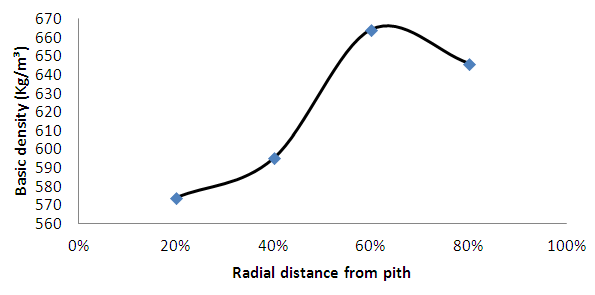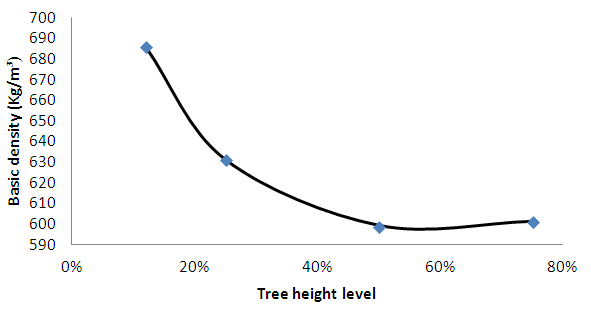-
Paper Information
- Paper Submission
-
Journal Information
- About This Journal
- Editorial Board
- Current Issue
- Archive
- Author Guidelines
- Contact Us
International Journal of Agriculture and Forestry
p-ISSN: 2165-882X e-ISSN: 2165-8846
2016; 6(1): 8-11
doi:10.5923/j.ijaf.20160601.02

Basic Density and Its Variation in Olea capensis Established in Matrix with Grevillea robusta Grown in Meru-Usa Forest Plantation, Tanzania
Revocatus Petro1, Osmond A. Ndomba2, Maneno Y. Chidege2, Francis Laswai1, Geofrey Nyaradani1
1Tanzania Forestry Research Institute (TAFORI), Morogoro, Tanzania
2Tropical Pesticides Research Institute (TPRI), Arusha, Tanzania
Correspondence to: Revocatus Petro, Tanzania Forestry Research Institute (TAFORI), Morogoro, Tanzania.
| Email: |  |
Copyright © 2016 Scientific & Academic Publishing. All Rights Reserved.
This work is licensed under the Creative Commons Attribution International License (CC BY).
http://creativecommons.org/licenses/by/4.0/

Basic density and its variation were determined in Olea capensis (Knobl.) of 53 years grown in matrix with Grevillea robusta in Meru-Usa Forest Plantation, Arusha, Tanzania. A total of four O. capensis trees were sampled. Diameter at breast height (Dbh) and total height for each sampled tree were measured before felling. Four disks, each measuring 5 cm thick were cut at 1.3 m (12%), 25%, 50% and 75% of total tree height from each tree for the purpose of determining basic density. Standards methods were used for determination of basic density. It was found that basic density ranged from 440 kg/m3 to 820 kg/m3 and the average value was 646 kg/m3. It was found that basic density decreased from the bottom to the top end of the tree and in radial direction increased from pith to the middle and then decreased towards the bark. Wood from O. capensis established in matrix with G.robusta was classified as heavy, which is similar classification to that of O. capensis grown in monoculture plantations. It is therefore recommended that wood of O. capensis established in matrix with G.robusta to be assigned similar uses as O. capensis grown in monoculture plantations as both have heavy basic densities.
Keywords: Wood basic density, Olea capensis, Grevillea robusta, Matrix, Meru plantation, Tanzania
Cite this paper: Revocatus Petro, Osmond A. Ndomba, Maneno Y. Chidege, Francis Laswai, Geofrey Nyaradani, Basic Density and Its Variation in Olea capensis Established in Matrix with Grevillea robusta Grown in Meru-Usa Forest Plantation, Tanzania, International Journal of Agriculture and Forestry, Vol. 6 No. 1, 2016, pp. 8-11. doi: 10.5923/j.ijaf.20160601.02.
Article Outline
1. Introduction
- Olea capensis Knobl (Oleaceae) is commonly known as black iron wood, East African olive or loliondo. It is an indigenous tree of humid and dry mountainous forests characterized by a straight bole with average height between 10 - 20 m and may exceed 30 m for well developed individual’s best sites [1-4]. In Tanzania, the species is commonly found in the dry upland forests of the Southern Highlands, Uluguru, Usambara, Meru and Kilimanjaro Mountains [2]. It grows well in areas within an altitude of 800 - 2600 m, mean annual rainfall of 800-2500 mm, mean annual temperature of 14 - 18°C and deep, loamy and fertile type of soil [5]. The species is known to grow naturally in areas of volcanic soil [6]. The tree produces high quality timber with dark brown heartwood and is attractively figured, fine-grained and hard [2-4]. The heartwood, often traded as ‘ironwood’, is in high demand for flooring, carpentry and panelling, and is widely used for house and bridge construction, counter and table tops, railway sleepers, tool handles and wagon parts [4]. The high demand for high quality timber trees particularly in Tanzania made O. capensis to become rare and protected from uncontrolled harvesting [5]. It is also used as fuelwood, fodder and the bark is used in local medicine [7]. The oily fruits are edible and are used in southern Africa in the preparation of beer and lemonade. The tree is considered sacred by the Maasai people and is commonly used in ceremonies [4].Olea capensis in monoculture plantation develops multiple leaders between 2 and 3 m above ground [8]. Moreover, the foliage of these trees turns yellow as compared to greenish foliage of nested planted O. capensis. Grevillea robusta has been reported to be best nurse tree for nest planted O. capensis [8]. In Sakila range in Meru-Usa forest plantation, experimental plots were established in early 1960’s to study the performance of O. capensis when planted with other species as nursing trees. The objective of this study was therefore to determine basic density and its variation in O. capensis established in 1962 in matrix with G. robusta grown in Sakila range in Meru-Usa forest plantation, Tanzania. The results from this study will be used in making recommendations which will lead to efficient utilization of wood of O. capensis established in matrix with G. robusta and wood of O. capensis from monoculture plantations.
2. Methods
2.1. Study Area Description
- Data were collected from O. capensis trees planted in 1962 at Sakila range in Meru-Usa Forest Plantation. The plantation is located within Mount Meru forest reserve in Arumeru and Arusha districts, Arusha region, Tanzania. The plantation lies between latitude 3°15'-3°18' South and longitudes 36°41'-36°42' East, at an altitude of 1,345 m above sea level. The area receives mean annual rainfall range of 844 - 1,040 mm which is highest in April and May [9]. Generally the area has cool temperature with an average of 20°C. The favourable temperature for O. capensis growth falls between 14 to 18°C [9]. The area has deep, dark brown or black and well drained soil with pH 5.5-6.5 [10, 11].
2.2. Matrix Planting Arrangement of O. capensis and G. robusta at Meru-Usa Forest Plantation
- About 458 hectares (ha) were planted with O. capensis in matrix arrangement with G. robusta. Olea capensis was grown in plantations in clusters of up to 10 trees at close spacing (1 m × 1 m) with nurse trees of G. robusta planted at 2.5 x 2.5 m. An interval of 7 - 8 m was maintained between the clusters [4, 8].
2.3. Collection of Study Materials
- Four clusters of O. capensis were randomly selected from Sakila range whereby one tree from each cluster was selected for the study. Diameter at breast height (Dbh) and total height for each sampled tree were measured before felling. Four disks of 5 cm thick were taken from each O. capensis at 1.3 m (12%), 25%, 50% and 75% of total tree height. The samples were immediately wrapped in polythene bags and transported to the Moshi Timber Utilization Research Centre, Moshi where laboratory work was carried out.
2.4. Sample Preparation and Recording
- Standard methods were used in preparation and recording of samples [12, 17, 18, 19]. A wedge running from pith to bark was cut from each disk. Four samples were cut at 20%, 40%, 60% and 80% of wedges’ total length. All specimens were soaked in distilled water until when they attained green volume condition. Green volume was obtained using the displacement method in accordance with Archimedes’ principle [12]. The test specimens were then oven dried at a temperature of 103 ± 2°C until constant weight and then cooled in desiccators. Specimens were reweighed and the weights recorded. The following formula was used to calculate basic density: Basic density (Kg/m3) = [Oven dry weight (Kg) / Green volume (m3)].
2.5. Data Analysis
- Microsoft Excel program was used in analysis of data. Analysis of variance (ANOVA) was done to study radial and axial variation in basic density between and within O. capensis.
3. Results
3.1. Average Basic Density
- Average basic density of O. capensis was found to be 646 kg/m3 with a range from 440 kg/m3 to 820 kg/m3. The average basic density value obtained in this study is lower than 737 kg/m3 reported from the same species in Tanzania [1]. Similarly, density value obtained in this study was lower than 753 kg/m3, 860–975 kg/m3 and 1169 kg/m3 for O. welwitschii, O. capensis and O. europaea respectively [1, 4]. Wood with basic density less than 400 kg/ m3 is classified as weak, 401 – 500 kg/ m3 fairly strong, 501 – 640 kg/ m3 strong, 641 – 800 kg/ m3 heavy and above 800 kg/ m3 as extremely heavy [13]. Therefore, wood from O. capensis established in matrix with G. robusta with 53 years were classified as heavy. The slight difference in basic density observed may be attributed to among other factors, growth conditions (tree spacing, matrix form, monoculture, soil, rainfall, temperature) and age of the tree.
3.2. Variation in Basic Density
3.2.1. Radial Variation
- Radial variation here is referred to the basic density variation from the pith to the bark of the trees. The variation in basic density in radial direction of O. capensis is presented in figure 1. Analysis of variance showed significant radial variation in basic density (F3,28 = 6.3.11; P = 0.02). Basic density increased from pith to the middle and then decreased towards the bark, i.e. 574 kg/m3 near the pith to 664 kg/m3 near the middle and 646 kg/m3 near the bark as shown in figure 1. The density variation pattern in this study is similar to that shown by traditional timbers of Tanzania [14].
 | Figure 1. Radial variation in basic density for O. capensis |
3.2.2. Axial Variation
- Axial variation is referred to the basic density variation from the bottom to the top of the trees. Axial basic density variation for O. capensis is presented in figure 2 that, basic density decreases with increases tree height but not statistically significant (F3, 28 = 1.430; P = 0.255). The trend shown in this study is similar to that shown by Artocarpus heterophyllus and Cocos nucifera grown in Tanzania [15, 16]. Decrease in O. capensis basic density from the bottom to the top could be attributed to variation in ratios of parenchyma cells and vascular bundles distribution at the butt, intermediate and top ends of the tree.
 | Figure 2. Axial variation in basic density for O. capensis |
4. Conclusions
- Results from this study showed that mean basic density of O. capensis established in matrix with G. robusta with 53 years grown at Meru-Usa forest plantation, Tanzania was 646 kg/m3. Basic density decreased from the butt to the top end of the tree and in radial direction increased from pith to the middle and then decreased towards the bark. Wood from this species established in matrix with G. robusta were classified as heavy, hence advised to used for heavy works. It is therefore, recommended that wood of O. capensis established in matrix with G. robusta to be assigned similar uses as O. capensis grown in monoculture plantations as both have heavy basic densities.
ACKNOWLEDGEMENTS
- Authors are wishing to acknowledge the following organizations and individuals who have provided valuable support and assistance to this study: Meru-Usa Forest Plantation for financial Support, Tanzania Forestry Research Institute (TAFORI) and Tropical Pesticides Research Institute (TPRI) for facilitating this study, Mr. Y. Chilongola for careful and concise sample preparation and determination of basic density. We wish to extend our thanks to Meru-Usa Forest Manager and Mr. A. Mgogo whose cooperation made this study possible.
 Abstract
Abstract Reference
Reference Full-Text PDF
Full-Text PDF Full-text HTML
Full-text HTML